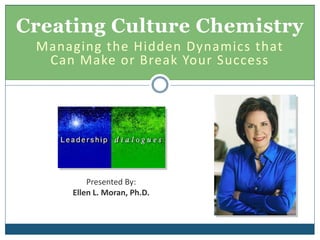
Creating Culture Chemistry
- 1. Creating Culture Chemistry Managing the Hidden Dynamics that Can Make or Break Your Success Presented By: Ellen L. Moran, Ph.D.
- 2. What’s Your Experience? We need someone who is more... Proactive Strategic Process oriented Innovative Customer focused
- 3. Success! We’ve found the right person! He’s what we need… • He can shake things up • Get us on the right track • He’s already delivering the right messages
- 4. The Problem... People don’t seem to be listening... Complaints about his style... He thinks things are worse than we told him...
- 5. Six Months Later This is concerning…
- 6. One Year Later What did we miss?
- 7. Consequences Hire someone more like the culture Give up on culture change Cynicism regarding leadership Potentially unnecessary career failure Reduced confidence in choosing the right person
- 8. Who has seen this movie before? Can you share a brief story?
- 9. What went wrong? • There was a key pattern (and language) mismatch • Good intentions, ineffective impact • Everyone is frustrated, but not sure why it happened or what to do about it (below conscious disconnect)
- 10. What’s the solution? Our Agenda • Become aware of the power of patterns • Discover some of our own • Apply this awareness • Connect and influence the culture
- 11. Patterns = Meta Programs What I Criteria decide • Direct our attention and Motivation What I prefer... thought processes • Describe characteristics of thinking, motivation and behavior • Influence our experiences • Patterns can make us effective or ineffective depending on the contexts
- 12. Criteria – What do you want in...X? What are Criteria? • Things that are important to us • Personal labels for values • Words that incite What’s important to you in a car?
- 13. Criteria – What do you want in...X? What are Criteria? • Hot buttons • Can be positive or negative • Composed of many elements, conscious and (mostly) unconscious
- 14. Examples Love = Make me laugh Be on time Spend time together Innovative = New Automated Novel
- 15. Specific Criteria Challenge Competence Recognition Ease Success Freedom
- 16. Specific Contexts Vacations Relationships Interviews Culture
- 17. Primary Criteria Questions • What do you want (in context – a job, a relationship, a particular thing, etc)? • Why is that important?
- 18. Discover yours • Use your work sheet • Consider your current job role or the one you want • Write down your answer to the criteria questions
- 19. Uses for Criteria • Decision making • Job competencies • Interviewing • Decoding the culture • Sales & Marketing • Customer Service • Team Dynamics
- 20. The Power of Criteria If there is no time for any other discover y • Probe and understand others’ criteria • Many other patterns emerge from criteria
- 21. Motivation Pattern Motivation Source – Internal/External Internal External
- 22. Discover Your Pattern U s e yo u r wo r ks h e e t Wr i te yo u r a n swe r to t h e q u e st i o n … H ow d o yo u k n ow yo u ’ve d o n e a go o d j o b at b e i n g … ( yo u r ro l e ) ?
- 23. Internal Positives • Evaluate things on the basis of what they think is appropriate • Provide their own motivation and make their own decisions • Decide about what they want to do and how they are doing
- 24. Internal Negatives • Have difficulty accepting other people's direction and feedback • May reject important feedback • May be seen as distant, arrogant or uncaring.
- 25. When Both Parties are Internal... Both sides believe: • The other is wrong or mistaken • Their motives are questionable • Both sides have difficulty listening to reach resolution
- 26. Company Culture • Listen carefully and respectfully to their criteria and past successes How can • Dig deeper to be sure you understand you apply • Do not imply you know more, have the answer or are imposing your standard this now? • Assume they are internal until you see signs they are looking for guidance
- 27. Other Patterns Can Be Important General Options • Achieve a goal or solve problems • Explore options or follow correct process Change Proactive • Take proactive measures or think through issues first • Change, evolve or hold on to what’s working • Tolerate difference or hold the line on standards • Stay focused on the big picture or pay attention to the details • And more….
- 28. Summary Strong internal pattern leads to disconnects and conflict Connect with criteria to influence and motivate Understand your personal criteria/driving patterns for clarity- confidence-motivation Listen for job/culture criteria to find the success connections
- 29. Motivation Patterns Reference Wo r d s t h a t C h a n g e M i n d s , S h e l l e Ro s e C h a r ve t Motivate Everyone, Jay Arthur